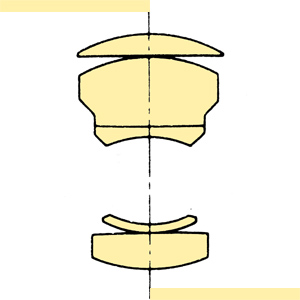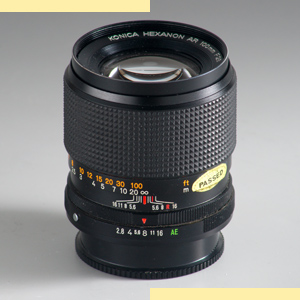Das Konica AR 2.8/100mm ist eine kleine und relativ lichtstarke Tele-Brennweite, die eine ungewöhnliche Sonnar-Xenotar-Habridkonstruktion aufweist. Das AR 2.8/100mm hat eine ganze Reihe von bekannten, ja legendären Mitbewerbern, allen voran natürlich die beiden 2.5/105mm Nikkore (Sonnar und Xenotar-Version). Ebenso gut und fast so bekannt sind das Canon (n)FD 2.8/100mm und die beiden Rechnungen des Minolta MC/MD 2.5/105mm. Weniger bekannt sind die entsprechenden Objektive von Topcon (RE 2.8/100mm, ein typisches und überaus kurz gebautes Sonnar), Pentax oder auch Olympus.
Das Konica AR 2,8/100mm wurde in zwei Haupt-Varianten gefertigt, die angeblich dieselbe optische Konstruktion teilen. Die frühere Version hat einen metallenen Fokus-Ring, die späteren einen Gummiwaffelring. Wie bei fast allen Konica AR Objektiven ist die Fassung präzise gefertigt; auch die Gravierungen sind gut ausgeführt. Die Fokussierung ist etwas schwergängig − ebenfalls typisch für Konica AR Objektive − und sicherlich nicht so seidenweich wie bei zeitgenössischen Minolta MC- oder Leica R-Objektiven. Eine weitere unangenehme Eigenschaft hat mit dem Blendenring zu tun − er geht recht streng (typisch für AR-Objektive), und er verriegelt sich leicht unabsichtlich in der "EE"- bzw. "AE"-Stellung. Zudem verhindert eine feststehende Riffelung in unmittelbarer Nähe des Blendenrings (der ebenfalls geriffelt ist), dass man den Blendenring leicht und intuitiv bedienen kann. All dies führt dazu, dass sich ein AR 2.8/100mm im Alltag wesentlich "störrischer" anfühlt als ein Minolta MC-II oder MC-X 2.5/100mm.
Die optische Leistung des AR 2.8/100mm ist sehr gut − und das kann man ebenso von den meisten Mitbewerbern sagen. Im Unendlich-Bereich sind die Bildecken schon bei Offenblende leidlich scharf (24 MP Vollformat), und die CAs sind recht gut korrigiert. Allerdings schneidet das AR 1.8/85mm diesbezüglich besser ab - eine Parallele zum Minolta-System, wo ebenfalls die 85er weniger CAs haben als die lichtstarken 100er. Im Gegensatz zum AR 1.8/85mm ist der Kontrast des AR 2.8/100mm schon bei Offenblende gut; er nimmt auch beim Abblenden nur unwesentlich zu.
Das Bokeh ist "sanft", aber ein 2/100mm oder erst recht ein 1.8/105mm können den Hintergrund natürlich stärker auflösen. Allerdings zeigt es sich oft, das bei einer Brennweite von 100mm auch eine Blende von f2.8 oder f4 recht gut geeignet ist, um "lebensechte" Portraits aufzunehmen und gleichzeitig den Hintergrund in Unschärfe auflösen zu können. Wer eine kleinere Tiefenschärfe wünscht, kann innerhalb des Konica-Systems z. B. auf das AR 1.8/85mm oder aber das AR 2.5/135mm zurückgreifen.
The Konica AR 2.8/100 mm is a relatively fast and small telephoto lens with an unusual Sonnar-Xenotar hybrid structure. It has a famous brethren such as the Nikkor Ai/AiS 2.5/105 mm versions, the Minolta MC/MD 2.5/100 mm, and the Canon FD 2.8/100 mm (a Xenotar type lens) − but we shouldn't forget the less famous ones such as the RE Topcor 2.8/100 mm (a beautiful Sonnar type lens), the Olympus Zuiko 2.8/100 mm, and the Pentax 2.8/100 mm variants.
The Konica AR 2.8/100 mm was produced in two main versions; it is said that they share the same optical construction. The earlier version has an all-metal focusing grip; the later has a rubber grip similar to the Canon new FD lenses. As with most Konica AR lenses, the lens barrel is precisely machined. All engravings are nicely made. Focusing is not as smooth as with contemporary Minolta MC-X or Leica R lenses, but that's a typical property of most Konica AR lenses. Another typical − and more annoying − feature of these lenses is their slightly weird aperture ring: it is much more difficult to turn than, say, the Minolta aperture ring. Turning requires more torque, and the ring easily locks in its "EE/AE" position. While none of these disadvantages is really serious, together they don't make life easier − especially if one is used to the flawless aperture rings from Minolta (or Nikon, or Canon, or ...).
The optical performance of the AR 2.8/100 mm is very good − and so is the performance of most other lenses of its class. At infinity on 24 MP FF, the corners are sharp even wide open. Chromatic aberration is well controlled, but not as low as with the AR 1.8/85 mm. Wide open, the contrast is very good, and it remains nearly identical when stopping down from f2.8 to f11 (unlike the AR 1.8/85 mm which has a low contrast wide open, a medium contrast at f2.8, and a high contrast from f4−f5.6 onwards).
The bokeh is good, but of course a 100 mm f2 or a 105mm f1.8 lens can dissolve the background even better. However, a focal length of 100 mm and an aperture of f2.8 (or even f4) often results in well balanced portraits. Those preferring a shallower depth-of field might go for the Konica AR 1.8/85 mm (slightly softer wide open than the 100 mm f2.8), or the Konica AR 2.5/135 mm.
 |
 |
KONICA HEXANON 100mm 1:2.8 (6 Linsen / 5 Glieder) |

